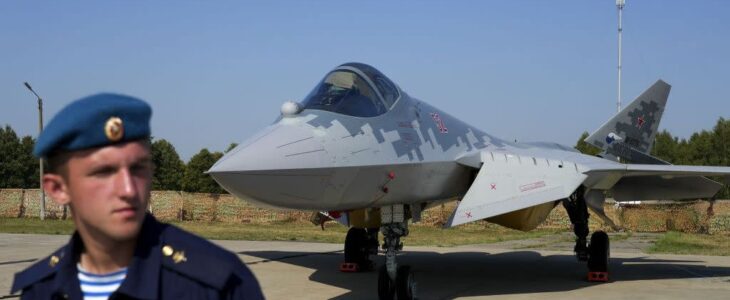
Russia’s top-of-the-line fighter is getting a performance boost from artificial intelligence (AI) that could make it more effective in combat.
The fifth-generation stealth Su-57 (Felon) will be equipped with AI-enabled communications systems, according to the state-owned Rostec corporation. The Felon is the latest aircraft to be equipped with AI, as manufacturers race to give planes autonomous capabilities.

“The equipment is designed for fifth-generation aircraft,” Rostec wrote on its website as translated by Google Translate. “Its use will improve the quality of information transfer between aircraft and ground complexes.”
AI for Radio
AI could give the Su-57 an advantage when it comes to electronic warfare. Rostec claims the system finds the most effective wireless channels in the Su-57’s vicinity and resists interference or jamming.

“The equipment ensures the reliability of information transmission due to noise-immune coding, interleaving of symbols in the message, common time synchronization in signal processing, the possibility of simultaneous transmission of messages over parallel channels, increasing the range of stable communication…,” Rostec wrote.
The new radio isn’t the first AI upgrade for the Su-57. An earlier Tass report claims that the SU-57 is getting an AI system that could help pilots make decisions while in combat.
The Su-57 is a twin-engine stealth multirole fighter aircraft developed by Sukhoi for the Russian Aerospace Forces. The aircraft is intended to replace the MiG-29 and Su-27, and first entered service in 2020.
Virtual Pilots
The Su-57 is among the fighters vying to be the first to be able to fly with AI help. The U.S. military is hoping that future sixth-generation fighter jets will have the option to fly without pilots.
The Air Force’s Next Generation Air Dominance (NGAD) program aims to develop a family of jets to succeed Lockheed’s F-22 Raptor. The program’s goals include autonomous aircraft and other abilities—ones that will give an edge in combat situations that are becoming increasingly rapid.
“What we’re finding now in manned-unmanned teaming is the squadrons are ready to start accepting more degrees of freedom to the system—not just going in a circle, but maybe cueing mission systems, maybe doing electronic warfare [or] doing comms functionality,” Gen. Mark Kelly, commander of Combat Air Command said in remarks quoted by National Defense.
AI is already piloting jets. An AI system recently flew a test aircraft for more than 17 hours at the U.S. Air Force Test Pilot School (USAF TPS) at Edwards Air Force Base in California.
AI could also help share information and coordinate actions among strike aircraft. For example, the UK, Italy, and Japan are developing a new fighter jet called Tempest that uses AI algorithms to enable interoperability and collaboration among allies. The Tempest could be flown without a pilot’s input, thanks to the novel computer systems.
Credit: Yahoo News
